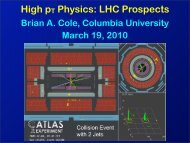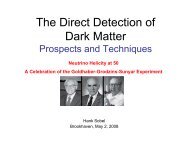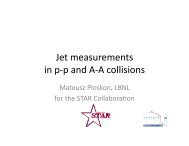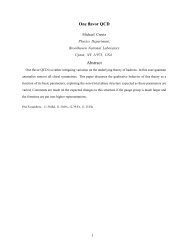Daniel de Florian
Daniel de Florian
Daniel de Florian
Create successful ePaper yourself
Turn your PDF publications into a flip-book with our unique Google optimized e-Paper software.
on kernels.<br />
The cross sections for the single-inclusive e<br />
e+e- (SIA) single-inclusive annihilation<br />
+ e− annihilation<br />
(SIA) into a specific hadron H,<br />
e + e − → (γ, Z) → H, (6)<br />
at a center-of-mass system (c.m.s.) energy √ s and integrated<br />
over the production angle can be written as<br />
[29, 30]<br />
1 dσ<br />
σtot<br />
H<br />
σ0<br />
= �<br />
dz q ê2 � H<br />
2 F1 (z, Q<br />
q<br />
2 ) + F H L (z, Q2 ) � . (7)<br />
The energy EH of the observed hadron scaled to the beam<br />
energy Q/2 = √ s/2 is <strong>de</strong>noted by z ≡ 2pH · q/Q2 =<br />
2EH/ √ s with Q being the momentum of the intermediate<br />
γ or Z boson.<br />
σtot = �<br />
ê<br />
q<br />
2 q σ0<br />
�<br />
1 + αs(Q2 �<br />
)<br />
(8)<br />
π<br />
is the total cross section for e + e− → hadrons including<br />
its NLO O(αs) correction and σ0 = 4πα2 (Q2 The cross sections for the single-inclusive e<br />
computed<br />
g spacelike<br />
n functions<br />
m-to-large<br />
olution kerr<br />
as z → 0,<br />
ns are cone<br />
splitting<br />
nant, large<br />
art, which<br />
nctions for<br />
perhaps, to<br />
e evolution<br />
le Q0 < Q.<br />
ortional to<br />
nt. While<br />
z behavior<br />
unique way<br />
ce by intronseparably<br />
corrections<br />
r mass cor-<br />
)/s. The<br />
s ofsums hadron in (7) and (8) run over the nf active quark flavors q,<br />
e factoriza- and the êq are the corresponding appropriate electroweak<br />
ation charges func- (see App. A of Ref. [24] for <strong>de</strong>tails).<br />
corrected”<br />
+ e− annihilation<br />
(SIA) into a specific hadron H,<br />
e + e − → (γ, Z) → H, (6)<br />
at a center-of-mass system (c.m.s.) energy √ s and integrated<br />
over the production angle can be written as<br />
[29, 30]<br />
1 dσ<br />
σtot<br />
H<br />
σ0<br />
= �<br />
dz q ê2 � H<br />
2 F1 (z, Q<br />
q<br />
2 ) + F H L (z, Q2 ) � . (7)<br />
The energy EH of the observed hadron scaled to the beam<br />
energy Q/2 = √ s/2 is <strong>de</strong>noted by z ≡ 2pH · q/Q2 =<br />
2EH/ √ s with Q being the momentum of the intermediate<br />
γ or Z boson.<br />
σtot = �<br />
ê<br />
q<br />
2 q σ0<br />
�<br />
1 + αs(Q2 �<br />
)<br />
(8)<br />
π<br />
is the total cross section for e + e− → hadrons including<br />
its NLO O(αs) correction and σ0 = 4πα2 (Q2 )/s. The<br />
sums in (7) and (8) run over the nf active quark flavors q,<br />
and the êq are the corresponding appropriate electroweak<br />
charges (see App. A of Ref. [24] for <strong>de</strong>tails).<br />
To NLO accuracy, the unpolarized “time-like” structure<br />
functions F H 1 and F H L in (7) are given by<br />
H 2 � values of z. On the one hand, the timelike evolution kernels<br />
in (4) <strong>de</strong>velop a strong singular behavior as z → 0,<br />
and, on the other hand, the produced hadrons are consi<strong>de</strong>red<br />
to be massless. More specifically, the splitting<br />
(T )<br />
(T )<br />
functions P gq (z) and P gg (z) have a dominant, large<br />
logarithmic piece � ln<br />
�<br />
� �<br />
2 H 2 H 2 2 z/z in their NLO part, which<br />
ultimately leads to negative fragmentation functions for<br />
z ≪ 1 in the course of the Q2 evolution and, perhaps, to<br />
unphysical, negative cross sections, even if the evolution<br />
starts with positive distributions at some scale Q0 < Q.<br />
At small z, also finite mass corrections proportional to<br />
MH/(sz 2 ) become more and more important. While<br />
there are ways to resum the singular small-z behavior<br />
to all or<strong>de</strong>rs in αs, there is no systematic or unique way<br />
to correct for finite hadron masses, for instance by introducing<br />
some “re-scaled” variable z ′ in SIA. Inseparably<br />
entwined with mass effects are other power corrections<br />
or “dynamical higher twists”.<br />
Anyway, including small-z resummations or mass corrections<br />
in one way or the other in the analysis of hadron<br />
production rates is not compatible with the factorization<br />
theorem and the <strong>de</strong>finition of fragmentation functions<br />
outlined above. “Resummed” or “mass corrected”<br />
fragmentation functions should not be used with fixed or<strong>de</strong>r<br />
expressions for, say, the semi-inclusive <strong>de</strong>ep-inelastic<br />
production of a hadron, eN → e ′ tegrated over the production angle can be<br />
[29, 30]<br />
1 dσ<br />
σtot<br />
HX, discussed in<br />
Sec. II C. Therefore we limit ourselves in our global<br />
analysis to kinematical regions where mass corrections<br />
and the influence of the singular small-z behavior of the<br />
evolution kernels is negligible. It turns out that a cut<br />
z > zmin = 0.05 (0.1) is sufficient for data on pion (kaon)<br />
production.<br />
Finally, conservation of the momentum of the fragmenting<br />
parton f in the hadronization process is summarized<br />
by a sum rule stating that<br />
H<br />
σ0<br />
= �<br />
dz q ê2 � H<br />
2 F1 (z, Q<br />
q<br />
2 ) + F H L (z, Q<br />
The energy EH of the observed hadron scaled t<br />
energy Q/2 = √ s/2 is <strong>de</strong>noted by z ≡ 2pH<br />
2EH/ √ s with Q being the momentum of the<br />
ate γ or Z boson.<br />
σtot = �<br />
ê<br />
q<br />
2 q σ0<br />
�<br />
1 + αs(Q2 �<br />
)<br />
π<br />
is the total cross section for e + e− → hadron<br />
its NLO O(αs) correction and σ0 = 4πα2 (Q<br />
sums in (7) and (8) run over the nf active qua<br />
and the êq are the corresponding appropriate e<br />
charges (see App. A of Ref. [24] for <strong>de</strong>tails).<br />
To NLO accuracy, the unpolarized “timeture<br />
functions F H 1 and F H L in (7) are given b<br />
2F H 1 (z, Q2 ) = �<br />
ê<br />
q<br />
2 �<br />
�DH q q (z, Q 2 ) + D H ¯q<br />
+ αs(Q2 ) � 1<br />
Cq ⊗ (D<br />
2π<br />
H q + DH¯q +C 1 g ⊗ D H �<br />
� 2<br />
g (z, Q ) ,<br />
F H L (z, Q 2 ) = αs(Q2 ) �<br />
ê<br />
2π<br />
q<br />
2 � L<br />
q Cq ⊗ (D H q<br />
+C L g ⊗ D H e<br />
tot q q<br />
h<br />
r The energy EH of the observed hadron scaled to the beam<br />
o energy Q/2 =<br />
n<br />
.<br />
o<br />
e<br />
r<br />
y<br />
-<br />
y<br />
s<br />
rn<br />
-<br />
-<br />
”<br />
ric<br />
n<br />
l<br />
s<br />
e<br />
t<br />
)<br />
-<br />
-<br />
)<br />
� 2<br />
g (z, Q ),<br />
√ s/2 is <strong>de</strong>noted by z ≡ 2pH · q/Q2 =<br />
2EH/ √ s with Q being the momentum of the intermediate<br />
γ or Z boson.<br />
σtot = �<br />
ê<br />
q<br />
2 q σ0<br />
�<br />
1 + αs(Q2 �<br />
)<br />
(8)<br />
π<br />
is the total cross section for e + e− → hadrons including<br />
its NLO O(αs) correction and σ0 = 4πα2 (Q2 )/s. The<br />
sums in (7) and (8) run over the nf active quark flavors q,<br />
and the êq are the corresponding appropriate electroweak<br />
charges (see App. A of Ref. [24] for <strong>de</strong>tails).<br />
To NLO accuracy, the unpolarized “time-like” structure<br />
functions F H 1 and F H L in (7) are given by<br />
2F H 1 (z, Q2 ) = �<br />
ê<br />
q<br />
2 �<br />
�DH q q (z, Q 2 ) + D H ¯q (z, Q2 ) �<br />
+ αs(Q2 ) � 1<br />
Cq ⊗ (D<br />
2π<br />
H q + DH¯q )<br />
+C 1 g ⊗ D H �<br />
� 2<br />
g (z, Q ) , (9)<br />
F H L (z, Q 2 ) = αs(Q2 ) �<br />
ê<br />
2π<br />
q<br />
2 � L<br />
q Cq ⊗ (D H q + D H ¯q )<br />
+C L g ⊗ D H� 2<br />
g (z, Q ), (10)<br />
with ⊗ <strong>de</strong>noting a standard convolution. The relevant<br />
NLO coefficient functions C1,L of the Q evolution and, perhaps, to<br />
cross sections, even if the evolution<br />
distributions at some scale Q0 < Q.<br />
ite mass corrections proportional to<br />
more and more important. While<br />
esum the singular small-z behavior<br />
here is no systematic or unique way<br />
hadron masses, for instance by introled”<br />
variable z<br />
q,g in the MS scheme can be<br />
found in App. A of Ref. [24].<br />
′ in SIA. Inseparably<br />
effects are other power corrections<br />
r twists”.<br />
g small-z resummations or mass coror<br />
the other in the analysis of hadron<br />
not compatible with the factorizahe<br />
<strong>de</strong>finition of fragmentation func-<br />
. “Resummed” or “mass corrected”<br />
ions should not be used with fixed orsay,<br />
the semi-inclusive <strong>de</strong>ep-inelastic<br />
dron, eN → e ′ HX, discussed in<br />
re we limit ourselves in our global<br />
ical regions where mass corrections<br />
the singular small-z behavior of the<br />
negligible. It turns out that a cut<br />
) is sufficient for data on pion (kaon)<br />
tion of the momentum of the fragn<br />
the hadronization process is sumle<br />
stating that<br />
1<br />
dzzD<br />
0<br />
H i (z, Q2 H<br />
2EH/<br />
) = 1, (5)<br />
√ s with Q being the momentum of the intermediate<br />
γ or Z boson.<br />
σtot = �<br />
ê<br />
q<br />
2 q σ0<br />
�<br />
1 + αs(Q2 �<br />
)<br />
(8)<br />
π<br />
is the total cross section for e + e− → hadrons including<br />
its NLO O(αs) correction and σ0 = 4πα2 (Q2 )/s. The<br />
sums in (7) and (8) run over the nf active quark flavors q,<br />
and the êq are the corresponding appropriate electroweak<br />
charges (see App. A of Ref. [24] for <strong>de</strong>tails).<br />
To NLO accuracy, the unpolarized “time-like” structure<br />
functions F H 1 and F H L in (7) are given by<br />
2F H 1 (z, Q2 ) = �<br />
ê<br />
q<br />
2 �<br />
�DH q q (z, Q 2 ) + D H ¯q (z, Q2 ) �<br />
+ αs(Q2 ) � 1<br />
Cq ⊗ (D<br />
2π<br />
H q + DH¯q )<br />
+C 1 g ⊗ D H �<br />
� 2<br />
g (z, Q ) , (9)<br />
F H L (z, Q 2 ) = αs(Q2 ) �<br />
ê<br />
2π<br />
q<br />
2 � L<br />
q Cq ⊗ (D H q + D H ¯q )<br />
+C L g ⊗ D H� 2<br />
g (z, Q ), (10)<br />
with ⊗ <strong>de</strong>noting a standard convolution. The relevant<br />
NLO coefficient functions C1,L At small z, also finite mass corrections proportional to<br />
MH/(sz<br />
q,g in the MS scheme can be<br />
found in App. A of Ref. [24].<br />
2 ) become more and more important. While<br />
there are ways to resum the singular small-z behavior<br />
to all or<strong>de</strong>rs in αs, there is no systematic or unique way<br />
to correct for finite hadron masses, for instance by introducing<br />
some “re-scaled” variable z ′ in SIA. Inseparably<br />
entwined with mass effects are other power corrections<br />
or “dynamical higher twists”.<br />
Anyway, including small-z resummations or mass corrections<br />
in one way or the other in the analysis of hadron<br />
production rates is not compatible with the factorization<br />
theorem and the <strong>de</strong>finition of fragmentation functions<br />
outlined above. “Resummed” or “mass corrected”<br />
fragmentation functions should not be used with fixed or<strong>de</strong>r<br />
expressions for, say, the semi-inclusive <strong>de</strong>ep-inelastic<br />
production of a hadron, eN → e ′ HX, discussed in<br />
Sec. II C. Therefore we limit ourselves in our global<br />
analysis to kinematical regions where mass corrections<br />
and the influence of the singular small-z behavior of the<br />
evolution kernels is negligible. It turns out that a cut<br />
z > zmin = 0.05 (0.1) is sufficient for data on pion (kaon)<br />
production.<br />
Finally, conservation of the momentum of the fragmenting<br />
parton f in the hadronization process is summarized<br />
by a sum rule stating that<br />
�<br />
� 1<br />
dzzD<br />
H 0<br />
H i (z, Q2 σtot =<br />
) = 1, (5)<br />
�<br />
ê<br />
q<br />
2 q σ0<br />
�<br />
1 + αs(Q2 �<br />
)<br />
π<br />
is the total cross section for e + e− → hadrons includi<br />
its NLO O(αs) correction and σ0 = 4πα2 (Q2 )/s. T<br />
sums in (7) and (8) run over the nf active quark flavors<br />
and the êq are the corresponding appropriate electrowe<br />
charges (see App. A of Ref. [24] for <strong>de</strong>tails).<br />
To NLO accuracy, the unpolarized “time-like” stru<br />
ture functions F H 1 and F H L in (7) are given by<br />
2F H 1 (z, Q2 ) = �<br />
ê<br />
q<br />
2 �<br />
�DH q q (z, Q 2 ) + D H ¯q (z, Q2 ) �<br />
+ αs(Q2 ) � 1<br />
Cq ⊗ (D<br />
2π<br />
H q + DH¯q )<br />
+C 1 g ⊗ D H �<br />
� 2<br />
g (z, Q ) ,<br />
F H L (z, Q 2 ) = αs(Q2 ) �<br />
ê<br />
2π<br />
q<br />
2 � L<br />
q Cq ⊗ (D H q + D H ¯q )<br />
+C L g ⊗ D H� 2<br />
g (z, Q ), (1<br />
with ⊗ <strong>de</strong>noting a standard convolution. The releva<br />
NLO coefficient functions C1,L <strong>de</strong>nsities. For instance, the singlet evolution equatio<br />
schematically reads<br />
d<br />
d ln Q<br />
q,g in the MS scheme can<br />
found in App. A of Ref. [24].<br />
2 � D H (z, Q 2 �<br />
) = ˆP (T )<br />
⊗ D� H �<br />
(z, Q 2 ), (2<br />
where<br />
�D H �<br />
H D<br />
≡ Σ<br />
DH �<br />
, D<br />
g<br />
H �<br />
Σ ≡ (D<br />
q<br />
H q + DH¯q ) (3<br />
and<br />
ˆP (T ) pplicability for fragmentation functions<br />
is severely limited to medium-to-large<br />
he one hand, the timelike evolution kerp<br />
a strong singular behavior as z → 0,<br />
r hand, the produced hadrons are conssless.<br />
More specifically, the splitting<br />
(T )<br />
) and P gg (z) have a dominant, large<br />
�Cross ln section <strong>de</strong>pends on two structure functions<br />
At NLO they can be written as<br />
Fragmentation functions <strong>de</strong>pend on both energy fraction (z) and<br />
energy scale : AP evolution<br />
Notice that SIA can only give information on the sum<br />
� �<br />
(T )<br />
(T )<br />
P qq 2nfP gq<br />
≡ 1 (T ) (T ) . (4<br />
P 2nf<br />
qg P gg<br />
2 z/z in their NLO part, which<br />
to negative fragmentation functions for<br />
se of the Q2 evolution and, perhaps, to<br />
ive cross sections, even if the evolution<br />
ve distributions at some scale Q0 < Q.<br />
finite mass corrections proportional to<br />
e more and more important. While<br />
o resum the singular small-z behavior<br />
s, there is no systematic or unique way<br />
te hadron masses, for instance by introscaled”<br />
variable z ′ in SIA. Inseparably<br />
ass effects are other power corrections<br />
gher twists”.<br />
ing small-z resummations or mass cory<br />
or the other in the analysis of hadron<br />
is not compatible with the factorizathe<br />
<strong>de</strong>finition of fragmentation funcove.<br />
“Resummed” or “mass corrected”<br />
ctions should not be used with fixed orr,<br />
say, the semi-inclusive <strong>de</strong>ep-inelastic<br />
hadron, eN → e ′ at a center-of-mass system (c.m.s.) energy<br />
HX, discussed in<br />
efore we limit ourselves in our global<br />
atical regions where mass corrections<br />
√ s and integrated<br />
over the production angle can be written as<br />
[29, 30]<br />
1 dσ<br />
σtot<br />
H<br />
σ0<br />
= �<br />
dz q ê2 � H<br />
2 F1 (z, Q<br />
q<br />
2 ) + F H L (z, Q2 ) � . (7)<br />
The energy EH of the observed hadron scaled to the beam<br />
energy Q/2 = √ s/2 is <strong>de</strong>noted by z ≡ 2pH · q/Q2 =<br />
2EH/ √ s with Q being the momentum of the intermediate<br />
γ or Z boson.<br />
σtot = �<br />
ê<br />
q<br />
2 q σ0<br />
�<br />
1 + αs(Q2 �<br />
)<br />
(8)<br />
π<br />
is the total cross section for e + e− → hadrons including<br />
its NLO O(αs) correction and σ0 = 4πα2 (Q2 )/s. The<br />
sums in (7) and (8) run over the nf active quark flavors q,<br />
and the êq are the corresponding appropriate electroweak<br />
charges (see App. A of Ref. [24] for <strong>de</strong>tails).<br />
To NLO accuracy, the unpolarized “time-like” structure<br />
functions F H 1 and F H L in (7) are given by<br />
2F H 1 (z, Q2 ) = �<br />
ê<br />
q<br />
2 �<br />
�DH q q (z, Q 2 ) + D H ¯q (z, Q2 ) �<br />
+ αs(Q2 ) � 1<br />
Cq ⊗ (D<br />
2π<br />
H q + DH¯q )<br />
�<br />
�<br />
To NLO accuracy, the unpolarized “time-like” struc






